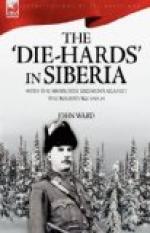MAKING AN ATAMAN
General Evan Pootenseiff arranged a parade of the 2nd Siberian Cossack Regiment outside Omsk on May 14 to say “Good-bye” to the “Anglisky Polkovnika,” his officers and soldiers. Needless to say, we were all there, and it was an occasion that will be remembered by all who had the honour to be present. Those who look upon the Cossacks as a sort of untrained irregular cavalry had better revise their ideas at once, for fear of further future miscalculations. The evolutions of this force in every branch of cavalry work are simply superb. The Cossack control of his horse, either singly or in combination, is not approached by any army in the world. The parade was under the immediate command of the Assistant Ataman, Colonel Bezovsky, and the wonderful display of horsemanship was loudly applauded by the English Tommies, who were the most interested spectators.
The parade over, the officers adjourned to an extremely artistic Kirghis tent pitched on a treeless plain, where lunch was served; but the viands were left untouched until the toast of “His Britannic Majesty” had been drunk in good Tsaristic vodka. Then it became a real military fraternisation. Officers inside, soldiers out. No civilian was allowed to approach within three versts, except the old Kirghis chief who, dressed in his picturesque native dress, had travelled over fifty versts to attend the function of making an English Ataman. The band of the Cossack regiment tried valiantly to enliven the proceedings with music, but the English marching choruses soon silenced all opposition. Then the Cossack commander called his men around, and giving time with his cowhide thong, led them through some of the most weird Cossack war songs it is possible to imagine. The difference in our mentality was never so well illustrated as in the songs of the two people. Ours were lively, happy, and full of frolic and fun; theirs were slow, sad wails, which can only come from the heart of a long troubled people. The songs of Ermak Tinothavitch, the conqueror of Siberia, were fierce and martial, but the strain of tragedy ran through them all.
Then the Cossacks placed their commander upon two swords and tossed him while singing the song of Stenkarazin, the robber chief, and at the end drew their swords and demanded toll, which took the form of five bottles extra. I was then admitted to the fraternity and presented with the Ataman’s badge, and after due ceremony with a Cossack sword, by the regiment, admitted to their circle. I went through the sword tossing, and gained freedom for 100 roubles; and here my narrative of the making of a Cossack had better end. Sufficient to say I never met a freer-hearted set of men in my travels round the world than these dreadful guardians of the Tsars, and if in course of time I get tired of England, I shall claim my kinship with these freemen of forest and plain. These men so love liberty that not even the Tsars dared interfere with their rights.




